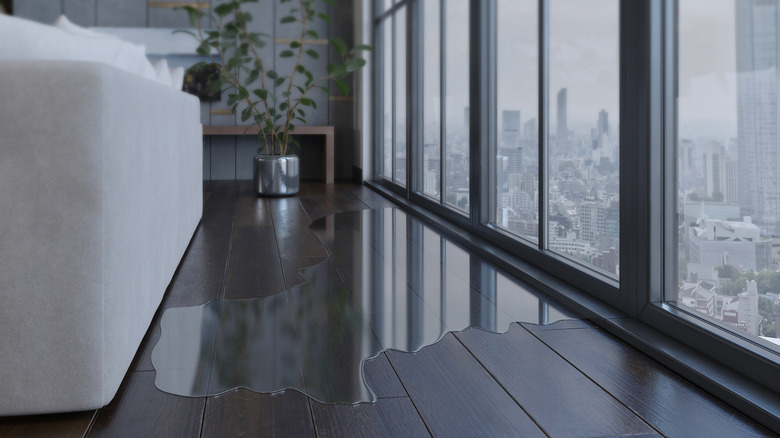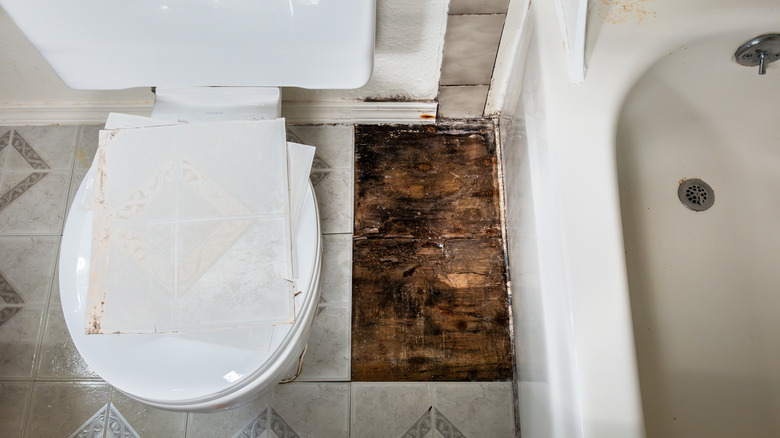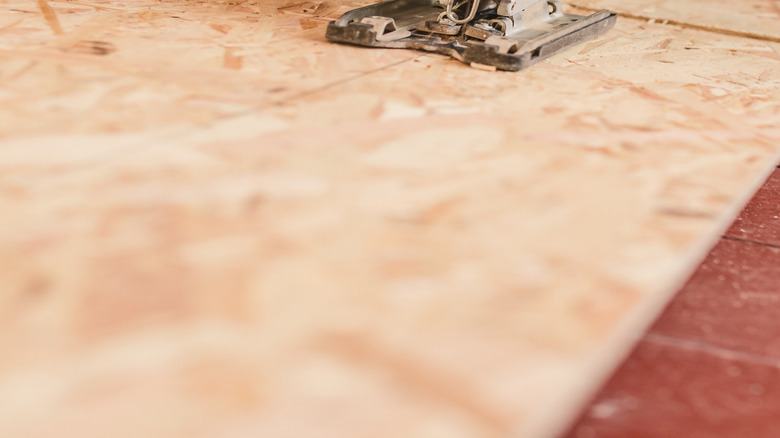Signs It May Be Time To Replace Your Water-Damaged Subfloor
You probably don't give them much thought, but the subfloors in your home are a crucially important part of the building. More than just a firm foundation for your beautiful hardwoods or tile, subfloors provide structural support and distribute weight evenly. We've all been in a house without solid subfloors. They're squeaky and uneven, which usually makes walking on them loud and, in cases where they're weak, wavy, or leaning, a little nerve-wracking. If you've ever had a plumbing leak or appliance failure, you probably focused on soaking up the water you could see. But according to Skylar Bartlett, owner at Kreer Construction, if your flooring feels bouncy, has a weird smell, or starts crumbling, these are serious signs it may be time to replace your water-damaged subfloor.
"Subfloors are literally the backbone of your floor system," Bartlett said during an exclusive interview with House Digest. The construction expert said the most common signs of water-damaged subfloors are soft spots or sagging, persistent mold or mildew, delamination or crumbling plywood, and warping or buckling. "If the floor feels spongy, bouncy, or uneven when you walk across it, the wood underneath has likely rotted," she explained. A funny smell is also a telltale sign. "Surface cleaning only goes so far. If you see black spots, smell a musty odor, or notice mold returning after cleaning, the damage is probably deeper in the subfloor," Bartlett cautioned. Floors that start to flake or become crumbly are also likely compromised, as are floors that are pulling away from the subfloor itself. According to Bartlett, "When it gets this bad, replacement is non-negotiable to restore the integrity of the floor."
Common causes of water-damaged subfloors
Spotting the signs that your home's subfloor needs to be replaced is important, but it's better to catch the culprits before too much damage is done. During her exclusive interview with House Digest, Skylar Bartlett said leaks are the likeliest cause. "Dripping pipes, failing seals around toilets, or hidden slow leaks under sinks are a big culprit." She added that appliances, like washing machines or water heaters, can quickly saturate a subfloor when they spring a leak. Although you'll know you have a big problem if your home floods after a major storm or a pipe bursts, slower leaks around roofs or windows are more subtle. "Water from above can work its way down through the walls and into subflooring," Bartlett cautioned. And she warned that humidity in badly ventilated bathrooms or basements can also cause subfloor damage over time.
Fortunately, if you catch the problem quickly enough, you may be able to repair your water-damaged subfloor instead of replacing it. "In some cases, you don't need to rip the whole thing out," Bartlett explained. She said repairs are possible if the damage is isolated, the wood is structurally sound, and you've addressed the moisture issue. "A small section (like under a leaky sink) can sometimes be cut out and patched without disturbing the rest of the subfloor." According to the construction expert, it's important to thoroughly dry and reinforce any damaged subflooring you intend to keep. "If the top layer looks stained or slightly warped but isn't soft, crumbling, or moldy, you might get away with sanding and sealing rather than full replacement."
Leave costly subfloor repairs to the professionals
Since they are important structural elements, repairing a damaged subfloor isn't your everyday DIY project. "For minor repairs, a confident DIYer with the right tools may be able to handle cutting out and patching a small area. But for anything involving mold remediation, structural framing repairs, and/or utility work... it's safer to call a pro," Skylar Bartlett said during her exclusive interview with House Digest. She explained that repairing incorrectly can cause sagging, squeaking, or bigger problems down the line.
So, how much will you spend replacing your subfloor? According to Bartlett, the costs vary depending on how much damage you need to address and where you live. "If it's just a small section, you might pay $200 to $500 for materials and labor," she explained. The construction expert said DIY can make your overall cost cheaper, but that it still requires the right tools and expertise. "A full subfloor replacement can range from $5 to $10 per square foot or more."
Expect the price to keep going up if your entire floor needs to be removed or if mold remediation is required. "For a typical room, that could run anywhere from $900 to $3,000 plus," Bartlett said. Although that might give you some sticker shock, especially when you'll also have to factor in the cost of purchasing and installing new flooring once your water-damaged subfloor has been repaired or replaced, according to Bartlett, "It's worth investing in a pro that can handle things the right way the first time."


